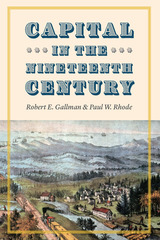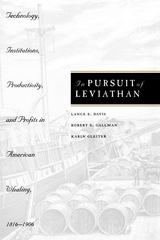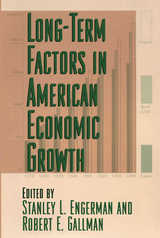4 books by Gallman, Robert E.

American Economic Growth and Standards of Living before the Civil War
Edited by Robert E. Gallman and John Joseph Wallis
University of Chicago Press, 1992
This benchmark volume addresses the debate over the effects of early industrialization on standards of living during the decades before the Civil War. Its contributors demonstrate that the aggregate antebellum economy was growing faster than any other large economy had grown before.
Despite the dramatic economic growth and rise in income levels, questions remain as to the general quality of life during this era. Was the improvement in income widely shared? How did economic growth affect the nature of work? Did higher levels of income lead to improved health and longevity? The authors address these questions by analyzing new estimates of labor force participation, real wages, and productivity, as well as of the distribution of income, height, and nutrition.
Despite the dramatic economic growth and rise in income levels, questions remain as to the general quality of life during this era. Was the improvement in income widely shared? How did economic growth affect the nature of work? Did higher levels of income lead to improved health and longevity? The authors address these questions by analyzing new estimates of labor force participation, real wages, and productivity, as well as of the distribution of income, height, and nutrition.
[more]

Capital in the Nineteenth Century
Robert E. Gallman and Paul W. Rhode
University of Chicago Press, 2020
Gives permanence and context to Gallman’s influential economic research on growth theory.
When we think about history, we often think about people, events, ideas, and revolutions, but what about the numbers? What do the data tell us about what was, what is, and how things changed over time? Economist Robert E. Gallman (1926–98) gathered extensive data on US capital stock and created a legacy that has, until now, been difficult for researchers to access and appraise in its entirety.
Gallman measured American capital stock from a range of perspectives, viewing it as the accumulation of income saved and invested, and as an input into the production process. He used the level and change in the capital stock as proxy measures for long-run economic performance. Analyzing data in this way from the end of the US colonial period to the turn of the twentieth century, Gallman placed our knowledge of the long nineteenth century—the period during which the United States began to experience per capita income growth and became a global economic leader—on a strong empirical foundation. Gallman’s research was painstaking and his analysis meticulous, but he did not publish the material backing to his findings in his lifetime. Here Paul W. Rhode completes this project, giving permanence to a great economist’s insights and craftsmanship. Gallman’s data speak to the role of capital in the economy, which lies at the heart of many of the most pressing issues today.
When we think about history, we often think about people, events, ideas, and revolutions, but what about the numbers? What do the data tell us about what was, what is, and how things changed over time? Economist Robert E. Gallman (1926–98) gathered extensive data on US capital stock and created a legacy that has, until now, been difficult for researchers to access and appraise in its entirety.
Gallman measured American capital stock from a range of perspectives, viewing it as the accumulation of income saved and invested, and as an input into the production process. He used the level and change in the capital stock as proxy measures for long-run economic performance. Analyzing data in this way from the end of the US colonial period to the turn of the twentieth century, Gallman placed our knowledge of the long nineteenth century—the period during which the United States began to experience per capita income growth and became a global economic leader—on a strong empirical foundation. Gallman’s research was painstaking and his analysis meticulous, but he did not publish the material backing to his findings in his lifetime. Here Paul W. Rhode completes this project, giving permanence to a great economist’s insights and craftsmanship. Gallman’s data speak to the role of capital in the economy, which lies at the heart of many of the most pressing issues today.
[more]

In Pursuit of Leviathan
Technology, Institutions, Productivity, and Profits in American Whaling, 1816-1906
Lance E. Davis, Robert E. Gallman, and Karin Gleiter
University of Chicago Press, 1997
In Pursuit of Leviathan traces the American whaling industry from its rise in the 1840s to its precipitous fall at the end of the nineteenth century. Using detailed and comprehensive data that describe more than four thousand whaling voyages from New Bedford, Massachusetts, the leading nineteenth-century whaling port, the authors explore the market for whale products, crew quality and labor contracts, and whale biology and distribution, and assess the productivity of the American fleet. They then examine new whaling techniques developed at the end of the nineteenth century, such as modified clippers and harpoons, and the introduction of darting guns. Despite the common belief that the whaling industry declined due to a fall in whale stocks, the authors argue that the industry's collapse was related to changes in technology and market conditions.
Providing a wealth of historical information, In Pursuit of Leviathan is a classic industry study that will provide intriguing reading for anyone interested in the history of whaling.
Providing a wealth of historical information, In Pursuit of Leviathan is a classic industry study that will provide intriguing reading for anyone interested in the history of whaling.
[more]

Long-Term Factors in American Economic Growth
Edited by Stanley L. Engerman and Robert E. Gallman
University of Chicago Press, 1986
These classic studies of the history of economic change in 19th- and 20th-century United States, Canada, and British West Indies examine national product; capital stock and wealth; and fertility, health, and mortality. "A 'must have' in the library of the serious economic historian."—Samuel Bostaph, Southern Economic Journal
[more]
READERS
Browse our collection.
PUBLISHERS
See BiblioVault's publisher services.
STUDENT SERVICES
Files for college accessibility offices.
UChicago Accessibility Resources
home | accessibility | search | about | contact us
BiblioVault ® 2001 - 2024
The University of Chicago Press









